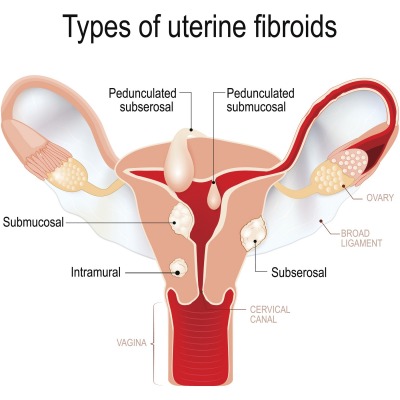What Are Uterine Fibroids?
Uterine fibroids are benign tumors in the uterus. They are composed of the same smooth muscle fibers as the uterine wall (myometrium) but are much denser than normal myometrium. This condition affects approximately 20 to 40 percent of premenopausal women, but only 5 to 10 percent of premenopausal women actually develop symptoms due to fibroids.
Unlike other tumors, these benign growths do not commonly spread to other regions of the body and are not typically dangerous. Developing fibroids are more prevalent in women who are overweight, African-American, over the age of 40, have high blood pressure, do not have children, or have first-degree relatives with fibroids. The diagnosis is typically confirmed by transvaginal ultrasound or magnetic resonance imaging (MRI) of the pelvis.
COMMON SYMPTOMS OF UTERINE FIBROIDS:
- Pelvic pressure or pain
- Heavy menstrual bleeding—breakthrough bleeding between periods
- Abdominal bloating
- Back pain
- Pain with intercourse
- Constipation
- Frequent urination
- Fatigue

Types of Fibroids

- Intramural Fibroids
Intramural fibroid tumors are the most common fibroids. These develop within the uterine wall and expand from there. When expanded, the intramural fibroid tumor makes the uterus feel larger than normal and may be mistaken for pregnancy or weight gain. This type of fibroid tumor can also cause “bulk symptoms” (e.g., pelvic pain, back pain, and pelvic bloating). The additional pressure placed on surrounding organs by the growth of the fibroid causes frequent urination and constipation. - Subserosal Fibroids
Subserosal fibroids develop on the outer uterine wall. This type of fibroid tumor can continue to grow outward increasing in size. The growth of a subserosal fibroid tumor will put additional pressure on the surrounding organs, causing pelvic pain and pressure. They typically have less impact on menstrual bleeding/menstrual flow. - Submucosal Fibroids
Submucosal fibroids are the least common type of fibroid. These fibroids develop just under the lining of the uterine cavity. Large submucosal fibroid tumors may increase the size of the uterus cavity and block the fallopian tubes, often causing fertility complications. Associated symptoms include heavy menstrual bleeding, prolonged menstruation, passing of clots, and frequent soiling. - Pedunculated fibroids
Pedunculated uterine fibroids occur when a fibroid tumor grows on a stalk, resulting in pedunculated submucosal or subserosal fibroids. These fibroids can grow into the uterus and/or on the outside of the uterine wall. Symptoms include pain and pressure, as the fibroids can sometimes twist on the stalk.
Our providers are nationally recognized experts in minimally invasive therapies for uterine fibroids.
We provide treatment for uterine fibroids for patients throughout Western, MA and Northern, CT.
To learn more about treatments available at New England Endovascular Center call 413-693-2852 to make an appointment.
